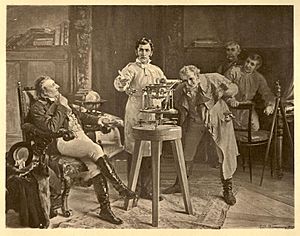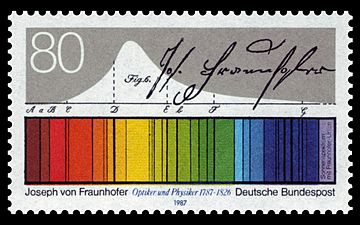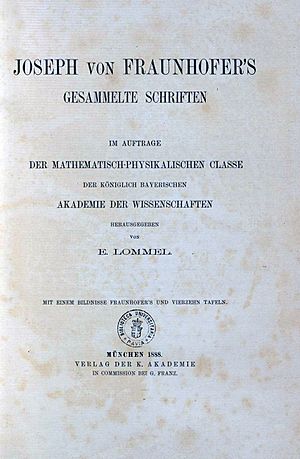Joseph von Fraunhofer facts for kids
Quick facts for kids
Joseph von Fraunhofer
|
|
|---|---|
 |
|
| Born | 6 March 1787 |
| Died | 7 June 1826 (aged 39) |
| Known for | Fraunhofer diffraction Fraunhofer lines Fraunhofer distance |
Joseph Ritter von Fraunhofer (born March 6, 1787 – died June 7, 1826) was a German physicist and a skilled maker of optical lenses. He created special optical glass and improved achromatic telescopes and objective lenses. He also invented the spectroscope, a tool used to study light, and developed diffraction grating. In 1814, he discovered and studied the dark lines in the spectrum of the sun. These are now famously known as Fraunhofer lines.
A large German research group, the Fraunhofer Society, is named after him. It is Europe's biggest group for advancing applied research.
Contents
Biography
Joseph Fraunhofer was the 11th child in his family. He was born in Straubing, in Bavaria. Sadly, he became an orphan at age 11. He then started working as an apprentice for a strict glassmaker named Philipp Anton Weichelsberger.
In 1801, the workshop where he worked collapsed. Joseph was trapped under the rubble. The rescue was led by Prince-Elector Maximilian Joseph. The prince helped Fraunhofer by giving him books. He also made sure Joseph's employer gave him time to study.
Another person who helped Joseph was Joseph Utzschneider. He was also at the disaster site. With money from the prince and support from Utzschneider, Fraunhofer could continue his education. In 1806, Utzschneider and Georg von Reichenbach invited Fraunhofer to their Institute. This institute was at Benediktbeuern, a former monastery focused on glassmaking. There, Joseph learned how to make excellent optical glass. He also invented precise ways to measure how light spreads out (called optical dispersion).
At the Institute, Fraunhofer met Pierre-Louis Guinand, a Swiss glass expert. Guinand taught Fraunhofer about glassmaking. By 1809, Fraunhofer was in charge of the mechanical part of the Optical Institute. He also became a partner in the company that same year. In 1814, Guinand and Reichenbach left the company. Guinand later became a partner with Fraunhofer again. The company was then renamed Utzschneider-und-Fraunhofer. In 1818, Fraunhofer became the director of the Optical Institute. Thanks to his amazing optical instruments, Bavaria became the world leader in optics. Even famous scientists like Michael Faraday could not make glass as good as Fraunhofer's.
His great work earned him an honorary doctorate from the University of Erlangen in 1822. In 1824, King Maximilian I made Fraunhofer a Knight. This gave him a noble title, "Ritter von." In the same year, he became an honorary citizen of Munich.
Like many glassmakers of his time, he was poisoned by heavy metal fumes. This caused his early death at age 39 in 1826. It is believed that his most valuable glassmaking secrets died with him.
Invention and Scientific Research
One of the hardest tasks in optics back then was accurately polishing the curved surfaces of large object glasses (lenses). Fraunhofer invented a machine that could polish surfaces more precisely than old methods. He also created other grinding and polishing machines. He greatly improved how different types of glass for optical instruments were made. He often found flaws in existing glass.
In 1811, he built a new kind of furnace. During his second time melting a large amount of glass, he found something important. He could produce flint glass that had the same refractive power whether it came from the top or bottom of a large container. He also found that English crown glass and German table glass had defects. These defects caused light to bend unevenly. In larger telescopes, these defects made the glass unsuitable for objective lenses. So, Fraunhofer started making his own crown glass.
Scientists found it hard to measure how much a material bent light and separated its colors. This was because the different colors in the spectrum didn't have clear boundaries. To fix this, Fraunhofer did experiments to create pure, single-color light. He used lamps and prisms to achieve this.
Discovery of Dark Absorption Lines
By 1814, Fraunhofer had invented the modern spectroscope. During his experiments, he found a bright, fixed line in the orange part of the spectrum when light came from fire. This line later helped him measure how much different materials bent light. He then used this knowledge to study the sun's light. He discovered 574 dark, fixed lines in the sun's spectrum. Today, millions of such lines are known.
Fraunhofer continued his research. He found dark lines in the light from several bright stars too. But these lines were arranged slightly differently for each star. He realized these lines were not caused by light passing through Earth’s atmosphere. If they were, they would all look the same. He concluded that the lines came from the stars and the sun themselves. They carried information about the light source, no matter how far away it was. He found that the light from Sirius and other bright stars was different from the sun's light and from each other. This discovery started the field of stellar spectroscopy.
These dark lines were later explained by Kirchhoff and Bunsen in 1859. They are mostly caused by atoms absorbing light. Some are also telluric lines, caused by oxygen in Earth's atmosphere. These lines are still called Fraunhofer lines in his honor. His discovery was much more detailed than the few lines noted by Wollaston in 1802.
Invention of Optical Instruments
Fraunhofer also developed a diffraction grating in 1821. This was after James Gregory discovered the idea of diffraction, and after David Rittenhouse made the first artificial diffraction grating in 1785. Fraunhofer was the first to use a diffraction grating to get clear line spectra. He was also the first to measure the wavelengths of these spectral lines using a diffraction grating.
However, his main interest was always practical optics. He once wrote that he focused only on things that helped make better optical instruments.
Telescopes and Optical Instruments
Fraunhofer made many optical instruments for his company. This included the Fraunhofer Dorpat Refractor, used by Struve in 1824. He also made the Bessel Heliometer, which was delivered after his death. Both were used to collect data for measuring stellar parallax (how stars appear to shift position). His company's next leaders, Merz und Mahler, made a telescope for the New Berlin Observatory. This telescope helped confirm the existence of the planet Neptune. Possibly the last objective lens Fraunhofer made was for a transit telescope at the City Observatory, Edinburgh. The telescope itself was finished by Repsold after Fraunhofer passed away.
Works
- Kurzer Umriß der Lebens-Geschichte des Herrn Dr. Joseph von Fraunhofer. By Joseph von Utzschneider. Rösl, 1826.
- (in de) [Opere]. München: Verlag der königlich Akademie. 1888. https://gutenberg.beic.it/webclient/DeliveryManager?pid=11945572.
- Prismatic and diffraction spectra: memoirs. By Joseph von Fraunhofer, William Hyde Wollaston. American Book Co., 1899.
See also
 In Spanish: Joseph von Fraunhofer para niños
In Spanish: Joseph von Fraunhofer para niños
- Fraunhofer (crater)
- German inventors and discoverers




